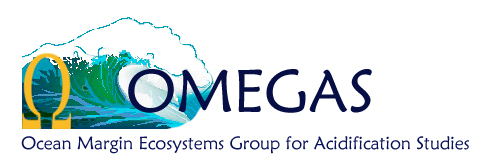 ©2020 Biological and Chemical Oceanography Data Management Office.
©2020 Biological and Chemical Oceanography Data Management Office.Funded by the U.S. National Science Foundation
Project abstract:
This project is a renewal of an existing ocean acidification (OA) grant supporting an interdisciplinary research team (called OMEGAS) with expertise in oceanography, ecology, biogeochemistry, molecular physiology, and molecular genetics. Research to date has documented a dynamic oceanographic mosaic in the inner shelf of the California Current System (CCS) that spans 1,200+ km and varies at tidal, diurnal, event, and seasonal temporal scales at local to ocean basin spatial scales. In OMEGAS II, the project seeks to better understand the drivers of this striking time-space variability, and to link the OA seascape to the physiological and ecological performance of a key member of this ecosystem, the mussel Mytilus californianus. In addition, the investigators will explore the influence of this oceanographic mosaic on species interactions and community organization. As a dominant habitat-forming species, strong interactor, and major space occupant, M. californianus is arguably the core component of the rocky intertidal ecosystem along the upwelling-dominated CCS. Using an interdisciplinary, spatially extensive approach integrating inner shelf oceanography with ecology, physiology, and eco-mechanics, the interdisciplinary team will study the response of juvenile mussels M. californianus to OA. The studies span levels of biological organization, thereby allowing assessment of how the cost of forming a shell under field conditions might influence physiological performance and resistance to predation. This investigation will include modeling to link to larger-scale ecosystem and oceanographic dynamics in the CCS and beyond.
Results from OMEGAS I show that the growth, survival, and shell strength of mussel larvae are strongly negatively affected by elevated pCO2, and that growth of adult mussels varied among sites within regions and between regions. Emerging data on natural variability in seawater conditions will allow a deeper exploration of the organismal response of M. californianus, and the ecological consequences of traits, such as reduced shell thickness and strength. The present project will expand and strengthen the existing oceanographic network to increase our understanding of the coastal OA regime, and provide the environmental context for ecological and physiological research. Specifically, this project will (1) conduct field and laboratory experiments on the influence of OA on the growth, shell accretion, and resistance to predation of juvenile mussels collected from 10 sites spanning 1,400 km of coastline, (2) link the OA-sensor oceanographic "backbone" to an existing database of community structure via ecological modeling to assess the influence of OA on coastal variation in community organization, (3) determine the physiological responses of juvenile mussels following field deployments and culture under common garden conditions to evaluate mechanistic underpinnings to the responses observed in mussels from different sites, (4) explore the physiological and transcriptomic response of mussels in lab mesocosms to field-documented variability in pCO2, and (5) using modified ROMS models, evaluate the linkage between basin-scale oceanography and local-scale variation in inner-shelf oceanography to evaluate the relative influences of large-to-local scale factors on OA variability. This research aims to understand how coastal ecosystems will respond to OA, and thus to develop our capacity to predict the future impact of OA on coastal ecosystems.
PUBLICATIONS PRODUCED AS A RESULT OF THIS RESEARCH
Hettinger, A., E. Sanford, T. M. Hill, J. D. Hosfelt, A. D. Russell, and B. Gaylord.. "The influence of food supply on the response of Olympia oyster larvae to ocean acidification.," Biogeosciences, v.10, 2013, p. 6629.
Hettinger, A., E. Sanford, T.M. Hill, E.A. Lenz, A.D. Russell, and B. Gaylord. "Larval carry-over effects from ocean acidification persist in the natural environment.," Global Change Biology, 2013.
Hofmann, G. E., T. G. Evans, M. W. Kelly, J. L. Padilla-Gamiño, C. A. Blanchette, L. Washburn, F. Chan, M. A. McManus, B. A. Menge, B. Gaylord, T. M. Hill, E. Sanford, M. LaVigne, J. M. Rose, L. Kapsenberg, and J. M. Dutton.. "Exploring local adaptation and the ocean acidification seascape ? studies in the California Current Large Marine Ecosystem.," Biogeosciences Discussions, v.10, 2013, p. 11825.
LaVigne, M. T.M. Hill, E. Sanford, B. Gaylord, A.D. Russell, E.A. Lenz, J.D. Hosfelt, M.K. Young.. "The elemental composition of purple sea urchin (Strongylocentrotus purpuratus) calcite and potential effects of pCO2 during early life stages.," Biogeosciences, v.10, 2013, p. 3465.
Pespeni, M.H., E. Sanford, B. Gaylord, T. M. Hill, J. D. Hosfelt, H. Jaris, M. LaVigne, E. A. Lenz, A. D. Russell, M. K. Young, S. R. Palumbi.. "Evolutionary change during experimental ocean acidification.," Proceedings National Academy of Sciences, v.110, 2013, p. 6937.
Additional data for this site are managed by and directly available from the project data site: http://omegas.science.oregonstate.edu/?q=http%3A//omegas.science.oregonstate.edu/data

Lead Principal Investigator: Bruce A. Menge
Oregon State University (OSU)
Principal Investigator: Gretchen E. Hofmann
University of California-Santa Barbara (UCSB-LifeSci)
Principal Investigator: Eric Sanford
University of California - Davis: Bodega Marine Laboratory (UC Davis-BML)
Co-Principal Investigator: Carol A. Blanchette
University of California-Santa Barbara (UCSB)
Co-Principal Investigator: Brian Gaylord
University of California - Davis: Bodega Marine Laboratory (UC Davis-BML)
Co-Principal Investigator: Tessa M. Hill
University of California - Davis: Bodega Marine Laboratory (UC Davis-BML)
Co-Principal Investigator: Ann D. Russell
University of California-Davis (UC Davis)
Co-Principal Investigator: Libe Washburn
University of California-Santa Barbara (UCSB-MSI)